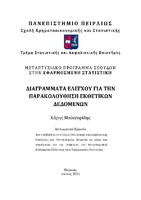Διαγράμματα ελέγχου για την παρακολούθηση εκθετικών δεδομένων
Control charts for monitoring exponential data

Προβολή/
Λέξεις κλειδιά
Διαγράμματα ελέγχου ; Διεργασίες υψηλής απόδοσης ; Κανόνες ροών ; Μέσο μήκος ροής (ARL) ; ANOSΠερίληψη
Για την παρακολούθηση των ελαττωμάτων σε μία διεργασία, η βασική υπόθεση που γίνεται είναι ότι ο αριθμός των ελαττωμάτων ανά μονάδα επιθεώρησης ακολουθεί την κατανομή Poisson και επομένως χρησιμοποιούνται τα κλασικά 𝑐 και 𝑢 διαγράμματα ελέγχου. Στις διεργασίες υψηλής απόδοσης, όπου ο ρυθμός εμφάνισης ελαττωμάτων είναι αρκετά χαμηλός, τα 𝑐 και 𝑢 διαγράμματα ελέγχου δεν είναι αποτελεσματικά, καθώς η κατανομή Poisson δεν μπορεί να προσεγγισθεί ικανοποιητικά από την κανονική, έχοντας ως αποτέλεσμα η πιθανότητα σφάλματος τύπου I που συνοδεύει τα διαγράμματα ελέγχου να είναι πολύ μεγαλύτερη από την επιθυμητή τιμή. Επιπλέον, δεν είναι δυνατόν να ανιχνευθεί περαιτέρω βελτίωση της παραγωγικής διεργασίας, αφού το κάτω όριο ελέγχου τίθεται ίσο με το μηδέν. Σε αυτές τις περιπτώσεις παρακολουθείται μια αθροιστική ποσότητα (χρόνος, μονάδες επιθεώρησης κ.α.) μέχρι την εμφάνιση 𝑟 ελαττωμάτων. Για 𝑟 = 1 η αθροιστική ποσότητα ακολουθεί την εκθετική κατανομή, ενώ για 𝑟 > 1 η αθροιστική ποσότητα ακολουθεί την Γάμμα κατανομή. Στην παρούσα διατριβή παρουσιάζονται συνολικά 79 διαγράμματα ελέγχου για την παρακολούθηση της αθροιστικής ποσότητας μέχρι την εμφάνιση 𝑟 ελαττωμάτων, όπου ορισμένα εξ αυτών μελετώνται για πρώτη φορά. Στο Κεφάλαιο 1 γίνεται μία εισαγωγή στα διαγράμματα ελέγχου και αναφέρονται τα κλασικά διαγράμματα. Στο Κεφάλαιο 2 παρουσιάζονται τα t και tr διαγράμματα ελέγχου (αμερόληπτα και μη). Στο Κεφάλαιο 3 μελετώνται τα 𝐴𝑅𝐿-αμερόληπτα t και 𝐴𝑅𝐿-αμερόληπτα tr διαγράμματα ελέγχου εφοδιασμένα με κανόνες ροών. Στο Κεφάλαιο 4 παρουσιάζονται τα εκθετικά διαγράμματα ελέγχου με μνήμη CUSUM και EWMA, καθώς και το εκθετικό CUSUM διάγραμμα ελέγχου με τη μέθοδο της άμεσης αρχικής αντίδρασης. Επιπλέον, υπολογίζεται το μέσο μήκος ροής (𝐴𝑅𝐿) για όλα τα διαγράμματα ελέγχου που παρουσιάζονται στη διατριβή. Στο Κεφάλαιο 5 πραγματοποιούνται διάφορες συγκρίσεις ανάμεσα στα διαγράμματα ελέγχου που παρουσιάστηκαν με βάση το 𝐴𝑁𝑂𝑆 (average number of observations to signal) και εξάγονται συμπεράσματα αναφορικά με τα αποδοτικότερα διαγράμματα ελέγχου για την ανίχνευση διαφόρων μετατοπίσεων στη διεργασία.


